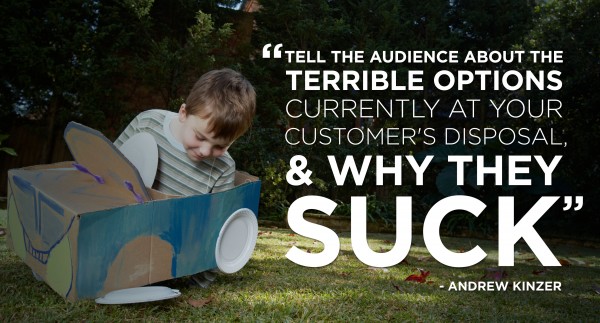Your pitch is the core of your presentation content. It represents your purpose, your call to action, and your future all in one. By definition, a “pitch” in the business world has nothing to do with a speeding curveball; instead, it describes the way that salespeople “throw” information at prospects. The very word “pitch” has also become more refined. “If someone is pitching to you, what are your options? If you are pitched at, you either swing to bat it away or duck to avoid it. Neither of these works well in sales.” – Nancy Bleeke, president of Sales Pro Insider. Also with a presentation, you are given a chance to refine your purpose with a longer amount of time, supplementary slides, and the existing attention of your audience. So, how can you craft a presentation pitch that’s more than just information thrown at 90 mph towards your audience? It all starts by doing a little bit of homework.
Develop Your Purpose
“82% of sales people are not aligned with the needs of their buyer. If you’re only espousing why you like the product — that value may be completely lost on the buyer.” (Source)
There are two parts to developing your pitch before you begin crafting your presentation content: the first is to understand your own purpose, and the second is to understand your audience. Start by answering the following questions about your product or service:
What am I offering?
Why does this matter to me?
Why would it matter to others?
Why now?
What are the positive outcomes of my product/service?
What would the future look like with my product/service in place?
The second half is to best understand your audience. Ask yourself these questions, or do some research to discover:
Who is my ideal customer?
What do they want?
What keeps them up at night?
How would my product/service best serve them?
Working on the central objective for your pitch should be easier once you understand these two elements; but now it’s time to refine the message. Can you summarize the core of your message in a sentence or two? Consider famous taglines from companies that say it all in a sentence or kind-of-a-sentence, like Allstate’s “Are you in good hands?” or the famous Bounty tagline: “The quicker picker-upper.” Make the core of this statement as to-the-point as it can possibly be. In the words of Albert Einstein, “If you can’t explain it simply, you don’t understand it well enough.”
The Structure of a Pitch
“If you want to build a ship, don’t drum up people to collect wood and don’t assign them tasks and work, but rather teach them to long for the endless immensity of the sea.” – Antoine De Saint Exupery
When we create presentations for startups and companies, it’s important to devise a structure that frames the pitch and can be filled in with key information. Below is a list of ingredients for a pitch, but think of them more like ingredients for a salad than a cake. With a cake, you aren’t as flexible and you should stick to a certain order. With a salad, really anything goes. Think back on your purpose to ensure you aren’t including wasteful pieces. For example, if you are making a product that currently has no competition, ignore that section and congratulations!
Problem – This is where you put yourself into your customer’s and audience’s shoes and then walk around for a while. What hassle, annoyance, or omission are they dealing with? Think back on the purpose of your pitch; what did you set out to improve when you came up with the idea?
Solution – This is an introduction to your product/service, so make it punchy and short. So you sell the softest bread in the world? “Say goodbye to stale, gross bread forever with YumBread.”
Why Now? – Depending on your product/solution, this can be a way to further enhance the solution. Is it important that things change soon? Why would it be important?
The Opportunity/Market Size – This is a way to share the scope of the problem, as well as give your audience a sense of growth. Let’s say you have information which suggests that 20 million households struggle with stale bread issues in the US alone, with an even larger scope of problems abroad. This will start to get the wheels of your audience’s mind turning.
The Competition – Again, only optional if it’s relevant. According to Andrew Kinzer on GroupTalent: “Tell the audience about the terrible options currently at your customer’s disposal, and why they suck. Tell your audience about how your customer has to waste their time hacking together a solution that wastes time and money.”
Practical Application/Financials – This isn’t the most engaging part of a presentation or pitch, but depending on your audience, most may want to see the proof inside of that tricky pudding. Keep this information to-the-point; don’t get artistic with your data. Consider including information about a short payback period, a value in measurable dollars, or a price/benefit comparison.
Call to Action – A call to action is by far the most important part of the pitch. It’s the “so what now?” moment that needs to be compelling enough to spring your audience into action. We’ve created a mini-guide to how to achieve the results you want and a more powerful call-to-action here.
The Close – An optional part of the pitch, but we usually like to include a throwback to the original problem or solution at the end of the presentation to remind the audience of the “why?” This is a great place to steal their hearts with an emotional or meaningful end. As Guy Kawasaki says, “Enchantment is the purest form of sales. Enchantment is all about changing people’s hearts, minds and actions because you provide them a vision or a way to do things better. The difference between enchantment and simple sales is that with enchantment you have the other person’s best interests at heart too.”
Refine Your Message and Delivery
If you have already started to develop the content of your pitch using each of the structural elements, then the next stage is to begin to edit and refine your message. This can be done by keeping in mind some traits of the very best pitches that we’ve seen and have created.
Minimalism – Time is money. Don’t clog up your slides or your delivery with anything that isn’t essential. Consider reading up on The Elevator Pitch; a classic delivery style that is meant to be shared in a crammed elevator between floors. You can apply that same technique to your own content to keep things concise.
Enthusiasm – If you’re not excited about your pitch, no one else is going to be. Go back and examine your purpose if you ever feel your enthusiasm draining. There is a reason you’ve decided to create your product/service: what is it?
Storytelling – We highly recommend this technique when crafting a pitch; there is irrefutable proof that storytelling works. It will engage your audience’s emotions, enhance their memory, and support your purpose effortlessly. Don’t just tell them why you are creating a product/service, tell them “how” you came to that conclusion. Share all of the sleepless nights, the cups of coffee, and the many roadblocks you and your idea faced. We’ve seen storytelling work firsthand for a pitch; it’s how Ethos3 came to be.
Urgency – Timeliness is everything. Give your audience a sense that answering your call-to-action will have immediate effect and matters today. Edit the content of that pitch to support this urgency using timely words like “now,” “today,” “soon,” “everyday.”
“As long as you show passion, you understand your target audience, and your pitch has a smart structure, you will succeed.” – Startup Bootcamp
Much rides on your ability to pitch your product/service in a presentation; your dreams are depending on it. But all of the passion, pervasiveness, and power are already within yourself. All three were developed the moment you conceived your idea as a way to solve, change, or improve the world. As you continue to work through the structure and details of the pitch, revisit your purpose to revitalize this concept. Trust us, you have the muscles to throw that perfect curveball.
Question: What elements of your pitch do you struggle with?



